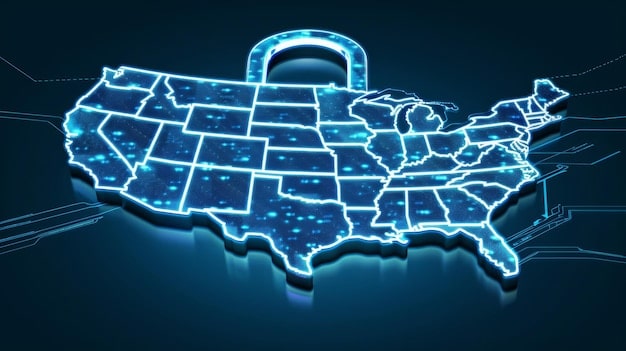Trump Administration Cybersecurity: Policies Protecting US Businesses

The Trump Administration’s approach to cybersecurity involved implementing new policies and executive orders to protect US businesses from cyber threats, focusing on strengthening federal networks and promoting information sharing.
The digital landscape has become a critical battleground, and the Trump Administration’s approach to cybersecurity: What New Policies are in Place to Protect US Businesses? reflects the urgent need to safeguard national interests and economic stability.
Understanding the Cybersecurity Landscape Under Trump
The Trump Administration’s approach to cybersecurity was marked by a proactive stance on protecting US businesses from increasingly sophisticated cyber threats. Recognizing the potential damage that cyberattacks could inflict on the economy and national security, the administration prioritized the development and implementation of new cybersecurity policies.
The administration’s focus extended beyond merely reacting to threats. The goal was to establish a comprehensive framework that anticipates and prevents cyberattacks and promotes resilience across both the public and private sectors.

This holistic approach reflects an understanding that cybersecurity is not just a technical issue; it’s fundamentally a strategic imperative for maintaining America’s competitive edge in the 21st century.
Key Cybersecurity Policies Introduced by the Trump Administration
Several key cybersecurity policies were introduced during the Trump Administration, each designed to address specific vulnerabilities and promote a more secure digital environment for US businesses. These policies encompassed a range of initiatives, from strengthening federal networks to fostering collaboration between government and the private sector.
Understanding these policies is crucial for businesses seeking to navigate the complex cybersecurity landscape and protect themselves from evolving threats.
Executive Order 13800: Strengthening the Cybersecurity of Federal Networks and Critical Infrastructure
Executive Order 13800, signed in May 2017, aimed to strengthen the cybersecurity of federal networks and critical infrastructure. This order directed federal agencies to assess and improve their cybersecurity capabilities.
It also called for the development of a cybersecurity workforce strategy to ensure that the government has the skilled personnel necessary to defend against cyber threats. The strategy encouraged greater collaboration between the public and private sectors to enhance cybersecurity information sharing.
National Cyber Strategy of the United States of America
Released in 2018, the National Cyber Strategy of the United States of America outlined a comprehensive approach to cybersecurity that emphasized deterrence, defense, and resilience. The strategy identified four pillars: protecting the American people, the homeland, and American way of life; promoting American prosperity; preserving peace through strength; and advancing American influence.
By implementing these pillars, the Trump administration sought to create a secure, reliable, and resilient cyber ecosystem that supports innovation, economic growth, and national security.
- Protecting the American people: Focused on reducing cybercrime and protecting privacy.
- Promoting American prosperity: Aimed at fostering a competitive digital economy.
- Preserving peace through strength: Focused on deterring malicious cyber activities.
- Advancing American influence: Sought to promote an open, interoperable, reliable, and secure internet.
These policies represented a significant investment in the nation’s digital infrastructure and reflected a commitment to safeguarding American interests in the digital age.
The Impact on US Businesses: Compliance and Adaptation
The cybersecurity policies introduced by the Trump Administration had a significant impact on US businesses, particularly in terms of compliance and adaptation. Businesses needed to understand the new requirements and take steps to ensure that their cybersecurity practices aligned with the government’s expectations.
This required investments in cybersecurity technology, training, and personnel, as well as a commitment to ongoing monitoring and improvement.
The policies emphasized the importance of risk management, incident response, and data protection. Companies were encouraged to adopt a proactive approach to cybersecurity, proactively identifying and mitigating vulnerabilities.

The Role of the Cybersecurity and Infrastructure Security Agency (CISA)
The Cybersecurity and Infrastructure Security Agency (CISA) played a crucial role in helping businesses navigate the new cybersecurity landscape. CISA provided resources, guidance, and technical assistance to help organizations improve their cybersecurity posture.
CISA also served as a central point of contact for coordinating cybersecurity efforts across the public and private sectors. By fostering collaboration and information sharing, CISA helped to create a more resilient cybersecurity ecosystem.
Ultimately, the Trump Administration’s approach to cybersecurity spurred many businesses to prioritize cybersecurity and invest in measures to protect their digital assets.
Challenges and Criticisms of the Trump Administration’s Approach
The Trump Administration’s approach to cybersecurity was not without its share of challenges and criticisms. Some observers argued that the administration’s policies were too focused on government control and lacked sufficient emphasis on individual privacy rights.
Others raised concerns about the potential for unintended consequences, such as stifling innovation or limiting economic competition. There were also questions about the effectiveness of the administration’s deterrence strategy and the ability to hold malicious cyber actors accountable.
Balancing Security and Privacy
One of the key criticisms centered on the balance between security and privacy. Some privacy advocates argued that the administration’s policies could lead to excessive surveillance and erode civil liberties. They raised concerns about the potential for government overreach and the lack of transparency in cybersecurity operations.
The administration countered that its policies were carefully designed to protect national security and economic interests while respecting individual privacy rights.
International Cooperation and Diplomacy
Another challenge involved international cooperation and diplomacy. The Trump Administration’s approach to foreign policy often strained relationships with key allies, making it more difficult to coordinate cybersecurity efforts and address global cyber threats.
Some critics argued that the administration’s unilateral approach undermined international norms and hampered the development of effective cybersecurity agreements.
Despite these challenges, the Trump Administration’s approach to cybersecurity undeniably raised awareness about the importance of cybersecurity and spurred significant improvements in the nation’s digital defenses.
Future Implications and the Evolving Threat Landscape
The cybersecurity policies enacted during the Trump Administration will likely have lasting implications for US businesses and the broader cybersecurity landscape. As the technological landscape continues to evolve, businesses must remain vigilant and adapt their cybersecurity practices to meet emerging threats.
The rise of artificial intelligence, quantum computing, and other emerging technologies presents both opportunities and challenges for cybersecurity. Businesses must invest in research and development to stay ahead of the curve and develop innovative solutions to protect their digital assets.
Ultimately, the future of cybersecurity will depend on the ability of governments, businesses, and individuals to work together to create a more secure and resilient digital ecosystem.
- Embracing Automation: Implementing automated security solutions can help businesses respond more quickly to cyberattacks.
- Enhancing Threat Intelligence: Staying informed about the latest cyber threats is crucial for defending against them.
- Prioritizing Data Protection: Protecting sensitive data should be a top priority for all businesses.
While questions remain about the long-term impact of the Trump Administration’s policies, their contribution to the evolving conversation around cybersecurity is undeniable.
Conclusion: Evaluating the Trump Administration’s Cybersecurity Legacy
The Trump Administration’s approach to cybersecurity was marked by a proactive and assertive stance on protecting US businesses from cyber threats. While the administration faced challenges and criticisms, its policies undoubtedly raised awareness about the importance of cybersecurity and spurred significant improvements in the nation’s digital defenses.
By strengthening federal networks, promoting information sharing, and fostering collaboration between the public and private sectors, the administration laid the foundation for a more secure and resilient cybersecurity ecosystem. As the threat landscape continues to evolve, businesses must build upon this foundation and remain vigilant in the face of emerging challenges.
| Key Point | Brief Description |
|---|---|
| 🛡️ Executive Order 13800 | Strengthened federal network cybersecurity. |
| 🌐 National Cyber Strategy | Outlined a comprehensive cybersecurity approach. |
| 🏢 CISA’s Role | Provided resources and guidance to businesses. |
| ⚖️ Balancing Security | Addressed security versus privacy concerns. |
FAQ
▼
The main focus was to protect US businesses and federal networks from cyber threats by strengthening cybersecurity infrastructure and promoting information sharing between government and private sectors.
▼
Executive Order 13800 aimed to bolster the cybersecurity of federal networks and critical infrastructure by directing federal agencies to improve their cybersecurity capabilities and workforce.
▼
The four pillars include protecting the American people, promoting American prosperity, preserving peace through strength, and advancing American influence in cyberspace.
▼
The administration’s approach to foreign policy often strained relationships, making it challenging to coordinate international cybersecurity efforts, though the need for global defense was recognized.
▼
CISA provided resources, guidance, and technical assistance to help businesses improve their cybersecurity posture and served as a point of contact for public-private sector coordination.
Conclusion
In conclusion, the Trump Administration’s approach to cybersecurity involved significant policies aimed at protecting US businesses and infrastructure. While concerns were raised, the focus on strengthening digital defenses has had a lasting impact on the nation’s cybersecurity landscape.





